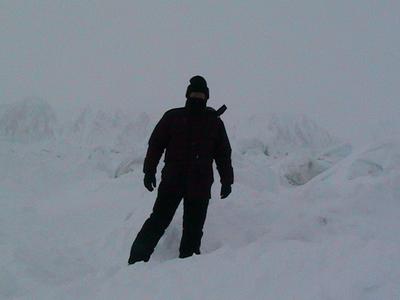30 March, 2003
The Science Shack
I woke up to a beautiful Sunday morning. Light
flurries of snow, temperature around zero and wind
chill about negative 10 degrees F. It was a slow day
for me a time to organize my gear and update my
journal. The rest of the team is busy with small
tedious tasks and minor adjustment to instruments in
the science shack.
The science shack is a small plywood shed that
contains all of the scientific monitoring equipment
that continuously monitor the water. The shack is
located outside beneath the high school building.
Within the cozy confines of the shack you will find
the thermosalinograph, three nutrient sensors,
fluorometer, two computers, an atmosphere of science
and not much standing room.
Seawater is pumped from the Bering Sea through a
hole in the ice located about 400 feet from shore. The
water pump itself hangs about five feet above the
bottom of the sea in about 15 feet of open water and
approximately 11 feet of ice above it. The water is
drawn through 420 feet of flexible insulated hose that
snakes across the ice and into the science shack.
Upon entering the 6 foot by 10 foot shack the water
is diverted to one of three instruments by various
valves. The majority of the water is directed through
the thermosalinograph where the waters temperature and
salinity is measured in order to calculate the
seawater density level.
A smaller portion of the water is directed through
a series of nutrient sensors, which measure the amount
of nitrates, phosphates and ammonium in the water.
Still another small portion is directed through the
fluorometer where the amount of chlorophyll is
detected and recorded.
Once the water is tested it is all returned back to
the sea through a drain located at the bottom of the
shack. All of the data collected is periodically
recorded on two computers that are in the shack.
So why go to all of the trouble to monitor seawater
in the Arctic? In simple terms, the Arctic Region
possesses some of the most nutrient rich waters in the
world and the area around Little Diomede is ideal for
monitoring due to its location. By measuring and
collecting information on the changes in the nutrient
levels and the microscopic beginning of the food
chain. It is hoped that the information can be used to
interpret the health, quality and stability of
organisms higher up on the food chain like beluga
whales, walrus, polar bears and seals. This region of
the world is extremely fragile and sustained changes
in nutrient level, temperature or salinity that are
abnormal can deeply impact all of the Arctic species,
including humans.

Ready for Arctic research

Hose leading from drill site to science shack

Vince Kelly adds chemicals to nutrient sensors in the science shack.
Contact the TEA in the field at
.
If you cannot connect through your browser, copy the
TEA's e-mail address in the "To:" line of
your favorite e-mail package.
|
